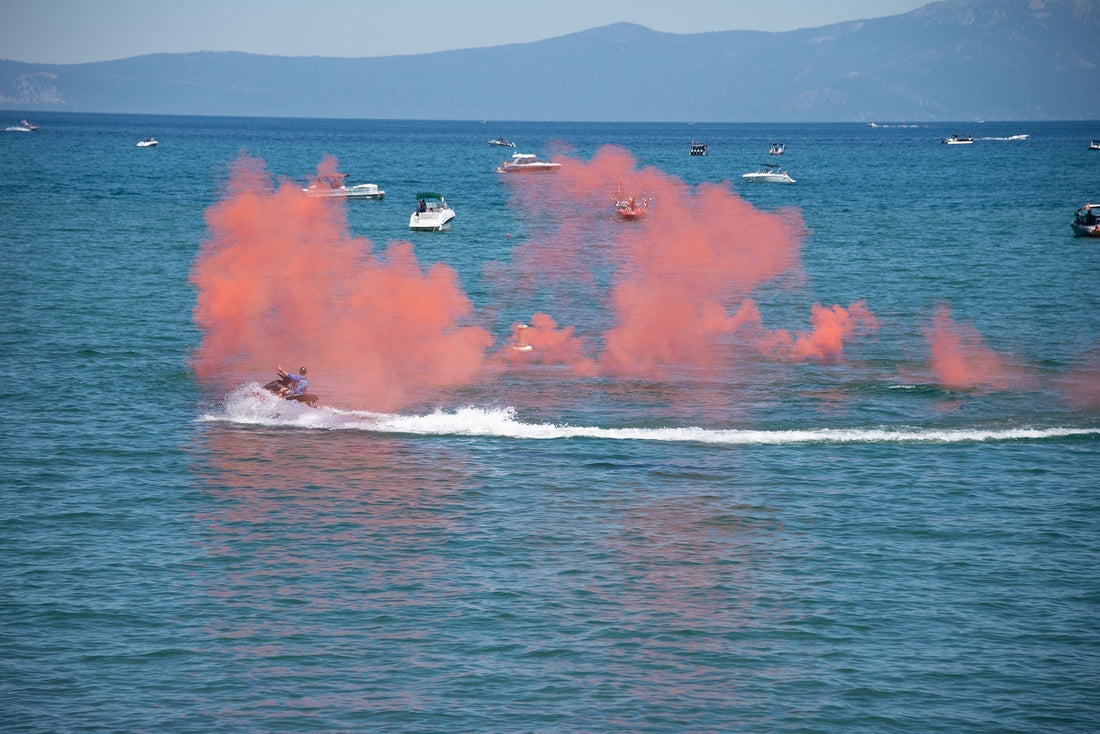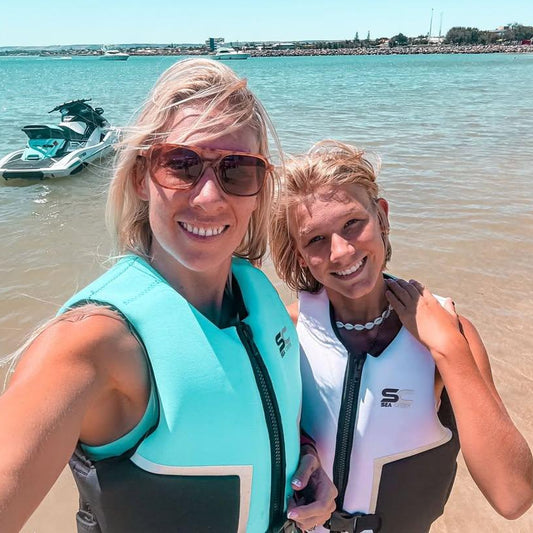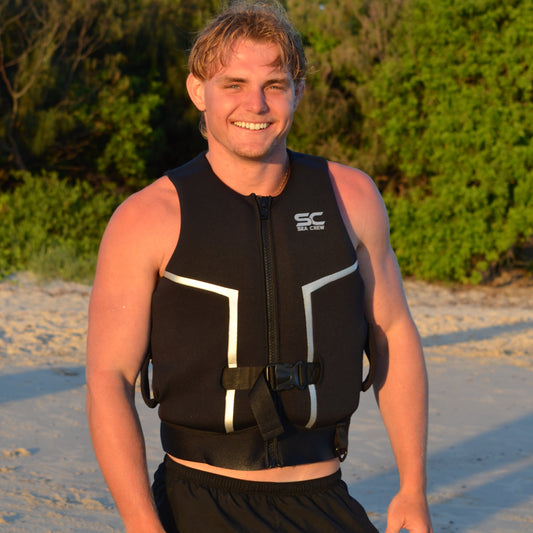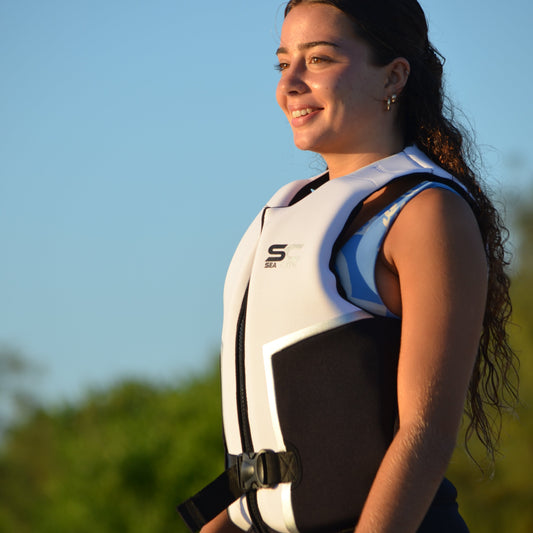
Flares for Jet Skis and Boats
All the information you need to know about flare requirements in Australian waters.
- What flares do I need?
- When do I need to carry flares?
- Storage.
- Expiry dates.
- Safe use of flares.
- Disposal.
Flares required for all vessels are generally purchased as a kit of four flares. The kit will normally have 2 x orange smoke flares and 2 x hand held red flares (confusingly called an inshore flare kit, but generally required to head offshore). Flare kits are also available as "offshore kits" containing 2 x orange smoke and 2 x red parachute rockets. Flares can be purchased in other forms, and as individual flares too. As well as flares, there are requirements to carry other items on your jet ski or boat, such as life jackets etc, but in this article we are just looking at flares.

Examples of flare kits & storage containers
Flare requirements in Australia do differ slightly by states
In Qld if you are taking your jet ski or boat into smooth waters, you are not required to carry any flares. If you are travelling into partially smooth waters or open ocean you must carry 2 x red hand flares as well as 2 x orange smoke flares with you.
NSW uses the terms enclosed waters and open waters. You will need to carry 2 x red hand flares as well as 2 x orange smoke flares in NSW Open Waters.
Victoria requires all recreational vessels to carry flares on enclosed and coastal waters. In all waters of Victoria you are required to have 2 x red hand flares as well as 2 x orange smoke flares. Vessels operating more than 2 nautical miles offshore must also carry 1 x red star parachute rocket.
South Australia uses a safety check tool on their website, which is a bit awkward. Surprisingly it would appear from the check tool that a jet ski is only permitted to be operated in protected waters. Boats can operate offshore, but must carry flares, and a long list of other mandatory equipment. It would appear after completing many options on the check tool that 2 x red hand flares as well as 2 x orange smoke flares are required to be carried when operating outside of protected waters, and in some cases when offshore also 2 x red parachute flares.
Western Australia specifies offshore as unprotected waters (beyond 400m offshore) . You are required to carry 2 x red hand flares and 2 x orange smoke flares. From the 1st September 2026 in WA, red parachute flares will not be accepted as part of the required safety equipment.
Northern Territory requires flares to be carried at all times - in a river, sheltered waters or coastal waters. The requirement for the NT is 2 x red hand flares, 2 x orange smoke flares.
Tasmania recommends flares to be carried at all times, but they are not required in smooth waters. In Partially Smooth (Sheltered) waters you are required to carry 2 x red hand flares as well as 2 x orange smoke flares. In Open and Coastal waters you are required to carry 2 x red hand flares, 2 x orange smoke flares as well as 2 x red parachute flares.
Below are links to the state checklists, for you to check more detailed state specific flare requirements and information.
Storage
Flares should be carried in a water proof container, kept dry and must be accessible for use in an emergency. You can find cases made just for carrying flares, and a dry bag is also a great alternative for a jet ski.
Expiry
Flares are manufactured with a 3 year expiry date, which will be marked on the outer case of all flares. The problem is the expiry date is not counted from when you purchased the flare, it is from the manufactured date. So if the flare kit stays sitting on the store shelf for 6 months, then the flare kit will only be usable for another 2 years and 6 months. I recommend you check the expiry dates when buying flares, and try to find a store that sells them regularly so you don’t get caught out. Note in some states it is illegal to have expired flares, which are considered as unauthorised explosives.
You should be able to find links to the disposal sites for expired flares using the above state specific links. NSW even operates a mobile disposal system, where you can take your flares to a point (such as a boat ramp) for drop off. Dates and locations are available on the NSW website.
Safe use of flares
Beware flares can cause injury, and are a one use item. Try to communicate by radio or phone before using flares. Keep your flares dry and in a waterproof container. Flares should be kept in a place where they are easily accessible in an emergency situation. Only use flares that are within the expiry dates.
When using the flare always fire them pointing down wind, away from yourself and away from your craft. Ensure you are in a position where the flare will be seen. Wait until you are confident the flare will be seen by somebody who can offer assistance, before firing the flare. When the flare is finished, it will be hot. Don’t throw it into the boat, put it into a bucket of water to cool down.
Hand held flares show the exact position of vessel in distress. Parachute flares while highly visible, do not show the exact position of the vessel. The aircraft or ship must try to work out the position by the line of the rocket.
Orange smoke flares designed to be used during daylight, as they generally can’t be seen at night. Use as line of sight distress.
- Hold with arm out stretched.
- Point downwind.
- Don’t look at the flare.
- Can last up to approximately 1 minute.
- Can be seen from up to 4 km during the day, but wind can reduce visibility to less than 1km.
- Particularly good to be seen by search aircraft.
Red hand held flares can be seen during daylight and at night. Use as a line of sight distress.
- Hold with arm out stretched.
- Point downwind.
- Don’t look at the flare.
- Lasts approximately 1 to 3 minutes.
- Can be seen for approximately 4 to 6km during the day and 10 to 12km at night.
Parachute flares are visible during daylight and particularly visible at night. Use for long range distress signalling.
- Only fire outside and with a clear view to the sky, so as to not hit anything as the rocket fires.
- Fire pointing skywards.
- Can reach 300 metres fired vertically.
- Lasts less than a minute.
- Can be seen for up to 15km during daylight and 40km during night.
Check the details on your flare manufacturer for exact specifications and use of the flare. Many of the volunteer organisations run flare training days, and they are well worth attending.
Disposal of flares
All flares have an expiry date printed on the casing, and they must be disposed of after that date. Never throw old flares into the rubbish, or set them off to dispose of them. It is illegal to set off a flare unless you are genuinely in distress.
Flares contain explosive materials, and their chemical components degrade over time, which can render them unstable, unreliable and dangerous to use after the expiry date.
The best way to dispose of your old flares is to take them to a designated flare disposal location. All states have information listed on their websites about where to take your flares for disposal. It is best to check these sites for your best disposal place, as the locations can change and are updated as necessary. Many Coast Guard and VMR sites will also accept old flares.

Flare Disposal Bins at Southport Coast Guard office, Gold Coast.
Conclusion
We at Sea Crew hope you never need to use a flare in a distress situation, but if required hopefully this information will help to keep you safe. This information was correct at the time of posting in May 2025.
You can also keep safe wearing one of our stylish life jackets which are certified for use in Australia, and also come in some great colours, so you look great too.
Main image credit to Air National Guard - California - image taken during rescue training.


















